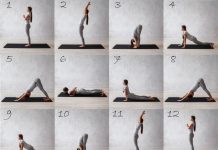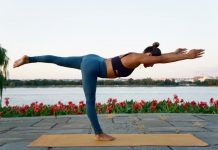If you have done some form of yoga, or were thinking of dabbling in yoga, or even if you merely read some articles about yoga, you might have heard of the word “Vinyasa” . Vinyasa is a flowing sequence of specific asanas coordinated with the movement of the breath.
This form of yoga developed as a “free-form” offshoot of the Ashtanga Yoga system . The Ashtanga system of yoga was developed by a yogi named Krishnamacharya, who taught Pattabhi Jois in the south Indian city of Mysore in the early 20th century. Ashtanga yoga has since then been popularized in the west by Jois’s students.
“Vinyasa” is derived from the Sanskrit term nyasa, which means “to place,” and the prefix vi, “in a special way”—as in the arrangement of notes in music.
Exactly as in a musical note arrangement, the sequence of the flow of the postures or asana change frequently. This can be thought of as flowing into the posture which is why it is also called “Flow Yoga”. The rhythmic flow of the asanas are designed for relaxation. Moving in and out of the posture gracefully is also a skill that one needs to develop to master the vinyasa sequence.
The breathing technique used for vinyasa yoga is called “ujjayi pranayama”. Practitioners inhale and exhale through the nose to complete fill and empty their lungs as they go through the sequence. When moving between poses, ujjayi breathing provides the connection.
The content of vinyasa classes change on a regular basis due to different arrangements of asanas. This is opposite to the fixed form asana where one performs the same postures in the same sequence each time.
Because the Vinyasa practice has a certain flow, speed, sequence and rhythm, it generates heat and sweat in the body and can give a cardio like feel. However there are also slow, gentle and restorative vinyasa practices for those who are not fans of high energy and fast vinyasa yoga. To give an idea, Sun salutation (or Surya Namaskar) is a form of vinyasa practice which has a series of 12 steps performed on each side (right and left).
Benefits of vinyasa yoga are detoxification, stress reduction, strength building, increased flexibility etc. Instead of focusing on the benefits of the vinyasa yoga, if we bring the “flowing” quality of the yoga into every part of our life, we not only gain the benefits, but also understand the rhythm of life itself. Think of it like a masterful surfer who studies the quality of the waves, practices with the waves regularly and eventually is able to effortlessly ride each wave as it comes without any stress or resistance. For the onlooker the surfer makes it looks easy. That is how living life should be – easy, effortless and thrilling.
Living life requires a certain synchronization with nature’s forces, abilities, intuition and the responsiveness to change course according to situations encountered. Hence, while practicing the asanas, it is important to understand that vinyasa yoga is more than a sequence of actions. Getting into the flow of the asana and aligning it with the breath makes it come alive within us, making it a means to raise our consciousness levels and connect the within and without seamlessly. Practice vinyasa yoga and be an expert surfer of life itself!
47 Most Famous Motivational Quotes of All-Time
49 Greatest Love Quotes
37 Inspirational Quotes that Will Change Your Life






























